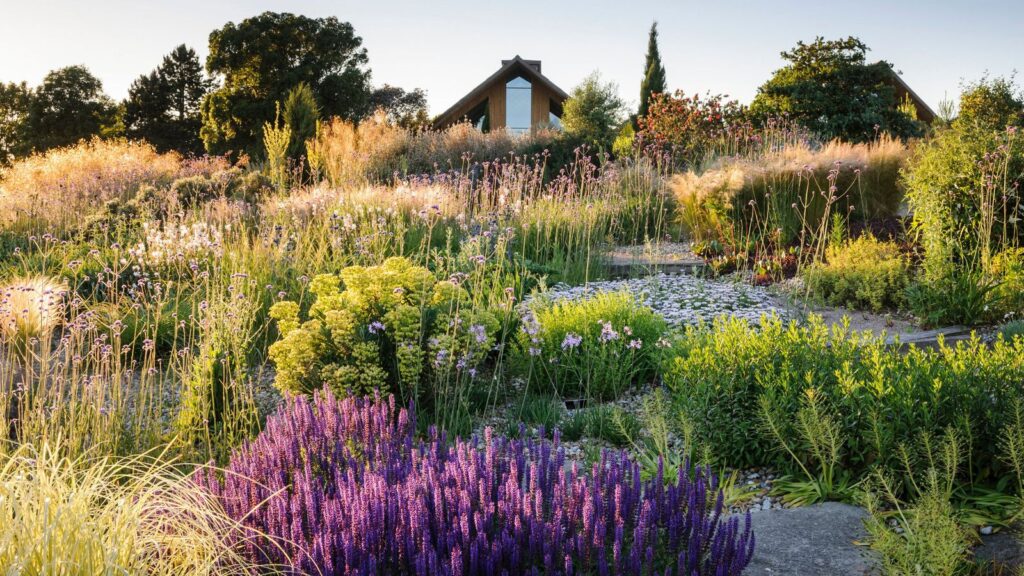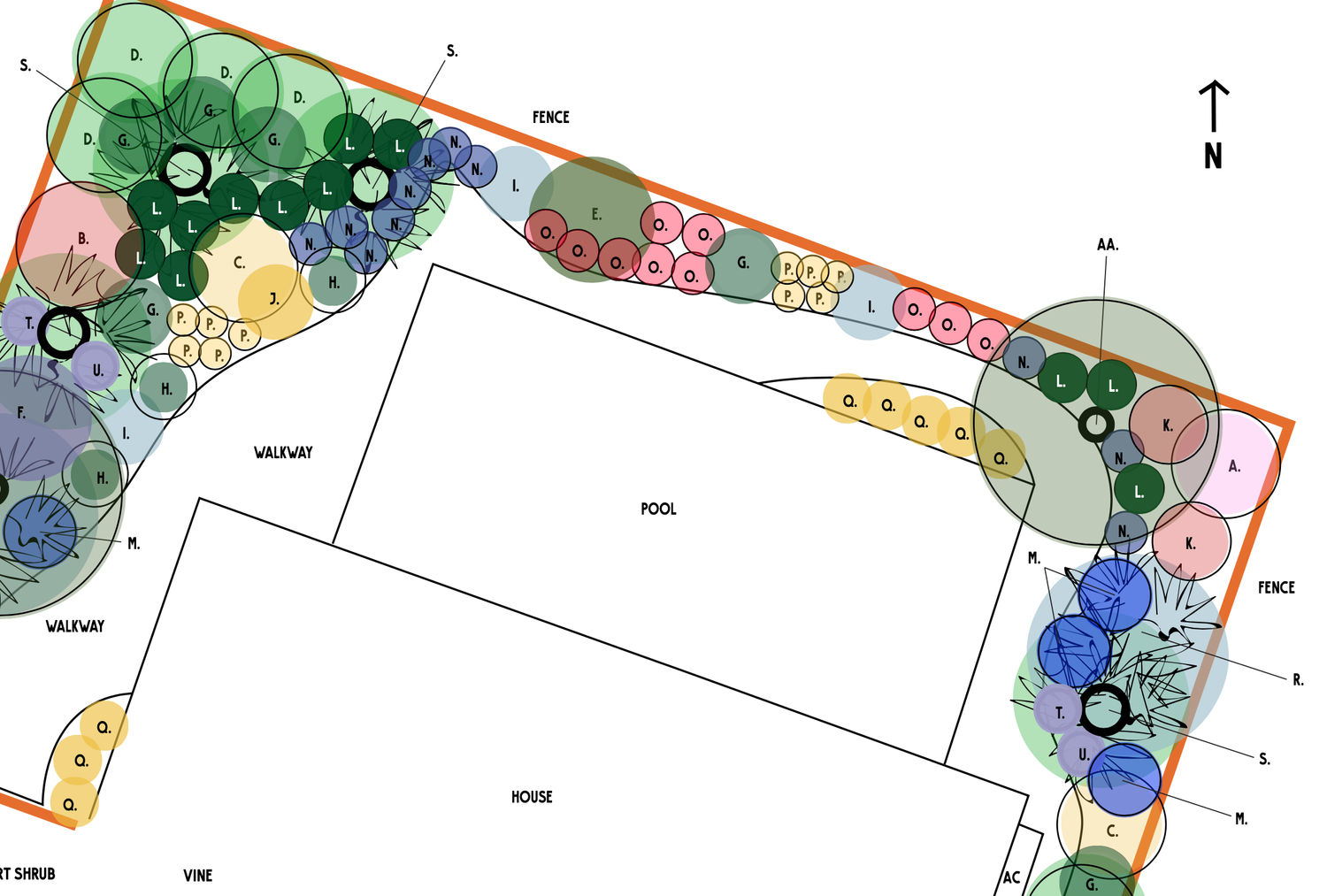
Introduction: The Blooming Appeal of Sustainable Garden Design
In an era marked by increasing environmental consciousness, the allure of sustainable garden design has blossomed from a niche trend into a mainstream movement. More than just aesthetically pleasing outdoor spaces, sustainable gardens represent a harmonious marriage of beauty and responsibility, where ecological balance takes precedence. This comprehensive guide delves into the heart of sustainable garden design, offering a wealth of inspiration and practical insights to help you create your own eco-friendly oasis.
Sustainable garden design is about creating gardens that are environmentally responsible and resource-efficient. It’s about working with nature, not against it. This means choosing plants that are native to your region, conserving water, reducing waste, and avoiding the use of harmful chemicals. It’s a holistic approach that benefits both the environment and the gardener.
Understanding the Core Principles of Sustainable Gardening
Before diving into specific design ideas, it’s crucial to grasp the fundamental principles underpinning sustainable gardening:
1. Water Conservation: A Lifeline for Sustainable Gardens
Water scarcity is a growing concern globally, making water conservation a cornerstone of sustainable garden design. Implementing efficient irrigation techniques and selecting drought-tolerant plants are essential. Consider these strategies:
- Drip Irrigation: Delivers water directly to plant roots, minimizing evaporation and runoff.
- Rainwater Harvesting: Collect rainwater in barrels or cisterns for later use.
- Xeriscaping: Design your garden with drought-tolerant plants that require minimal watering.
- Mulching: Apply organic mulch around plants to retain moisture in the soil.
2. Soil Health: The Foundation of a Thriving Ecosystem
Healthy soil is the bedrock of a flourishing garden. Sustainable gardening practices prioritize soil health through natural methods:
- Composting: Recycle kitchen and yard waste into nutrient-rich compost to enrich the soil.
- Cover Cropping: Plant cover crops like clover or rye to improve soil structure and fertility.
- No-Till Gardening: Avoid tilling the soil to preserve its natural structure and beneficial microorganisms.
- Organic Fertilizers: Use organic fertilizers like compost tea or fish emulsion to nourish plants.
3. Plant Selection: Embracing Native and Adaptive Species
Choosing the right plants is paramount in sustainable garden design. Native plants are perfectly adapted to the local climate and soil conditions, requiring less water, fertilizer, and pest control. Adaptive species, while not native, are also well-suited to the local environment.
- Native Plants: Support local ecosystems, attract pollinators, and require minimal maintenance.
- Pollinator Gardens: Plant flowers that attract bees, butterflies, and other beneficial insects.
- Edible Landscaping: Incorporate edible plants like herbs, vegetables, and fruit trees into your garden design.
- Vertical Gardening: Maximize space and create visual interest with vertical gardens.
4. Waste Reduction: Minimizing Environmental Impact
Sustainable gardening aims to minimize waste and promote recycling. Reduce your environmental footprint by:
- Composting: Recycle yard waste and kitchen scraps into valuable compost.
- Reusing Materials: Repurpose old containers, pallets, and other materials for gardening projects.
- Avoiding Plastic: Choose biodegradable pots and containers made from materials like coconut coir or bamboo.
- Reducing Packaging: Buy seeds and plants in bulk to minimize packaging waste.
5. Integrated Pest Management: A Natural Approach to Pest Control
Sustainable gardening eschews harmful chemical pesticides in favor of natural pest control methods. Implement integrated pest management (IPM) strategies to maintain a healthy garden ecosystem:
- Beneficial Insects: Attract beneficial insects like ladybugs and lacewings to prey on pests.
- Companion Planting: Plant herbs and flowers that repel pests or attract beneficial insects.
- Handpicking: Remove pests manually to prevent infestations.
- Organic Pest Control Sprays: Use organic pest control sprays like neem oil or insecticidal soap as a last resort.
Sustainable Garden Design Inspiration: A Gallery of Ideas
Now, let’s explore a diverse range of sustainable garden design ideas to spark your creativity:
1. The Native Plant Sanctuary: A Celebration of Local Flora
Transform your garden into a haven for native plants, showcasing the unique beauty of your region. Native plant sanctuaries not only support local ecosystems but also require minimal maintenance, as the plants are perfectly adapted to the local climate and soil conditions. Imagine a tapestry of wildflowers, grasses, and shrubs, buzzing with pollinators and providing habitat for local wildlife.
Consider incorporating features like a meandering path, a natural stone bench, and a small pond to enhance the sanctuary’s appeal. Add signage to educate visitors about the importance of native plants and their role in the ecosystem. This type of garden not only beautifies your property but also serves as an educational resource for your community.
2. The Edible Oasis: A Feast for the Senses and the Palate
Combine beauty and functionality by creating an edible oasis where you can grow your own fresh produce. Edible landscaping integrates herbs, vegetables, and fruit trees into your garden design, providing a sustainable source of food while enhancing the aesthetic appeal of your outdoor space. Picture rows of colorful vegetables, fragrant herbs, and bountiful fruit trees, all thriving in a harmonious ecosystem.
Design your edible oasis with raised beds, vertical gardens, and container gardens to maximize space and create visual interest. Choose plants that are well-suited to your climate and soil conditions, and consider incorporating companion planting to deter pests and attract pollinators. This type of garden not only provides fresh, healthy food but also promotes a deeper connection with nature.
3. The Wildlife Haven: A Sanctuary for Local Fauna
Create a garden that welcomes and supports local wildlife, providing food, water, and shelter for birds, butterflies, and other creatures. Wildlife havens are designed to mimic natural habitats, offering a safe and inviting space for animals to thrive. Imagine a garden teeming with life, where birds sing, butterflies flutter, and frogs croak in a symphony of nature.
Incorporate features like bird feeders, bird baths, butterfly houses, and bee hotels to attract wildlife. Plant native trees, shrubs, and flowers that provide food and shelter for animals. Create a small pond or stream to provide a water source. This type of garden not only enhances the beauty of your property but also contributes to the conservation of local biodiversity.
4. The Water-Wise Retreat: A Celebration of Drought-Tolerant Plants
Embrace the beauty of drought-tolerant plants and create a water-wise retreat that conserves water and minimizes maintenance. Xeriscaping, a landscaping technique that utilizes drought-tolerant plants, is ideal for regions with limited water resources. Imagine a garden filled with succulents, cacti, and other arid-adapted plants, creating a stunning visual display with minimal water consumption.
Design your water-wise retreat with gravel pathways, rock gardens, and drought-tolerant groundcovers. Choose plants that are well-suited to your climate and soil conditions, and consider incorporating features like a dry creek bed or a rain garden to manage stormwater runoff. This type of garden not only conserves water but also reduces your environmental footprint.
5. The Composting Paradise: A Recycling Hub for Garden and Kitchen Waste
Turn your garden into a composting paradise where you recycle yard waste and kitchen scraps into nutrient-rich compost. Composting is a sustainable gardening practice that reduces waste, improves soil health, and provides a natural fertilizer for your plants. Imagine a garden where nothing goes to waste, and everything is recycled back into the ecosystem.
Set up composting bins or tumblers in a convenient location in your garden. Collect yard waste like leaves, grass clippings, and twigs, as well as kitchen scraps like fruit and vegetable peels, coffee grounds, and eggshells. Layer the materials in your compost bins, and turn them regularly to promote decomposition. This type of garden not only reduces waste but also enriches your soil and provides a natural fertilizer for your plants.
6. The Vertical Garden Oasis: Maximizing Space and Adding Greenery
Transform any space, no matter how small, into a lush vertical garden oasis. Vertical gardens are a fantastic way to add greenery to balconies, patios, and even interior walls, maximizing space and creating a stunning visual impact. Imagine a wall covered in vibrant foliage, cascading flowers, and fragrant herbs, bringing the beauty of nature into your living space.
Construct your vertical garden using a variety of materials, such as pallets, trellises, and hanging planters. Choose plants that are well-suited to the light conditions and watering requirements of your space. Consider incorporating features like a drip irrigation system to ensure consistent watering. This type of garden not only adds beauty to your space but also improves air quality and provides a calming atmosphere.
7. The Sensory Garden: Engaging All the Senses
Create a sensory garden that engages all five senses, providing a therapeutic and stimulating experience for visitors. Sensory gardens are designed to appeal to sight, sound, smell, taste, and touch, offering a unique and immersive connection with nature. Imagine a garden filled with colorful flowers, fragrant herbs, rustling grasses, and textured leaves, creating a symphony of sensations.
Incorporate features like water fountains, wind chimes, and textured pathways to enhance the sensory experience. Choose plants that are known for their aromatic properties, such as lavender, rosemary, and mint. Include plants with interesting textures, such as lamb’s ear, sedum, and ornamental grasses. This type of garden not only provides a sensory experience but also promotes relaxation and well-being.
8. The Permaculture Paradise: Mimicking Natural Ecosystems
Design your garden using permaculture principles, mimicking natural ecosystems to create a self-sustaining and resilient landscape. Permaculture is a design system that seeks to create sustainable human habitats by observing and imitating natural patterns. Imagine a garden that functions as a miniature ecosystem, where plants, animals, and humans coexist in harmony.
Incorporate features like swales, berms, and guilds to manage water, improve soil fertility, and create diverse habitats. Choose plants that are mutually beneficial, such as companion plants that deter pests or attract pollinators. Design your garden with multiple layers, including trees, shrubs, herbs, and groundcovers. This type of garden not only provides food and resources but also promotes ecological balance and resilience.
9. The Cottage Garden Revival: A Romantic and Informal Landscape
Revive the charm and beauty of a traditional cottage garden, creating a romantic and informal landscape filled with flowers, herbs, and vegetables. Cottage gardens are known for their abundance of colorful blooms, their informal layout, and their mix of edible and ornamental plants. Imagine a garden overflowing with flowers, buzzing with bees, and exuding a sense of timeless beauty.
Incorporate features like winding pathways, stone walls, and climbing roses to enhance the cottage garden aesthetic. Choose plants that are known for their romantic appeal, such as roses, peonies, and lavender. Include herbs and vegetables to add functionality to the garden. This type of garden not only creates a beautiful and inviting space but also provides a source of food and fragrance.
10. The Minimalist Zen Garden: A Sanctuary of Peace and Tranquility
Embrace the simplicity and serenity of a minimalist Zen garden, creating a sanctuary of peace and tranquility. Zen gardens are designed to promote meditation and contemplation, using carefully arranged rocks, gravel, and plants to create a sense of harmony and balance. Imagine a garden that invites you to slow down, breathe deeply, and connect with your inner self.
Incorporate features like raked gravel, carefully placed rocks, and a limited number of plants to create a sense of order and simplicity. Choose plants that are known for their calming properties, such as bamboo, moss, and ferns. Maintain the garden meticulously, raking the gravel and pruning the plants to preserve its minimalist aesthetic. This type of garden not only provides a peaceful retreat but also promotes mindfulness and well-being.
Practical Tips for Implementing Sustainable Garden Design
Beyond inspiration, implementing sustainable garden design requires practical knowledge and planning. Here are some actionable tips to guide you:
- Start Small: Begin with a small section of your garden and gradually expand as you gain experience.
- Assess Your Site: Evaluate your soil type, sunlight exposure, and water availability before selecting plants.
- Plan Your Layout: Create a detailed plan of your garden, including the location of plants, pathways, and other features.
- Prepare Your Soil: Amend your soil with compost and other organic matter to improve its fertility and drainage.
- Water Wisely: Water deeply and infrequently, and use a soaker hose or drip irrigation system to conserve water.
- Mulch Regularly: Apply organic mulch around plants to retain moisture, suppress weeds, and regulate soil temperature.
- Fertilize Organically: Use organic fertilizers like compost tea or fish emulsion to nourish your plants.
- Control Pests Naturally: Implement integrated pest management strategies to prevent pest infestations.
- Maintain Your Garden: Regularly weed, prune, and fertilize your plants to keep them healthy and thriving.
- Observe and Adapt: Pay attention to your garden’s needs and adjust your practices as needed.
Overcoming Common Challenges in Sustainable Gardening
While sustainable gardening offers numerous benefits, it can also present challenges. Here’s how to overcome some common hurdles:
- Pest and Disease Management: Implement IPM strategies, choose disease-resistant plant varieties, and maintain good air circulation.
- Weed Control: Mulch regularly, hand-pull weeds, and use organic herbicides as a last resort.
- Soil Fertility: Amend your soil with compost and other organic matter, and use cover crops to improve soil structure and fertility.
- Water Scarcity: Choose drought-tolerant plants, implement water-wise irrigation techniques, and harvest rainwater.
- Time Commitment: Start small, plan your garden carefully, and prioritize tasks to manage your time effectively.
The Long-Term Benefits of Sustainable Garden Design
The benefits of sustainable garden design extend far beyond aesthetics. By embracing sustainable practices, you can:
- Reduce Your Environmental Footprint: Conserve water, reduce waste, and avoid the use of harmful chemicals.
- Support Local Ecosystems: Provide habitat for pollinators and other beneficial wildlife.
- Improve Soil Health: Enhance soil fertility and drainage through natural methods.
- Save Money: Reduce your water bill, fertilizer costs, and pest control expenses.
- Enhance Your Well-Being: Connect with nature, reduce stress, and enjoy the therapeutic benefits of gardening.
Conclusion: Cultivating a Sustainable Future, One Garden at a Time
Sustainable garden design is more than just a trend; it’s a commitment to creating a healthier planet and a more beautiful world. By embracing the principles and ideas outlined in this guide, you can transform your outdoor space into an eco-friendly oasis that benefits both the environment and your well-being. So, take the leap, get your hands dirty, and start cultivating a sustainable future, one garden at a time.
Remember, every small step towards sustainability makes a difference. Whether you’re planting a native wildflower garden, composting your kitchen scraps, or simply reducing your water consumption, you’re contributing to a more sustainable future. Let your garden be a reflection of your commitment to the environment, and inspire others to embrace sustainable practices in their own lives.
The journey towards sustainable garden design is an ongoing process of learning, experimenting, and adapting. Don’t be afraid to try new things, make mistakes, and learn from your experiences. With a little patience and dedication, you can create a garden that is not only beautiful but also environmentally responsible and ecologically beneficial.
So, go forth and create your own sustainable garden paradise. Let your garden be a testament to the power of nature, the beauty of sustainability, and the potential for a brighter future for all.


